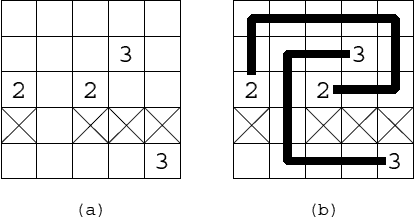当前你的浏览器版本过低,网站已在兼容模式下运行,兼容模式仅提供最小功能支持,网站样式可能显示不正常。
请尽快升级浏览器以体验网站在线编辑、在线运行等功能。
3133:Manhattan Wiring
题目描述
There is a rectangular area containing n × m cells. Two cells are marked with “2”, and another two with “3”. Some cells are occupied by obstacles. You should connect the two “2”s and also the two “3”s with non-intersecting lines. Lines can run only vertically or horizontally connecting centers of cells without obstacles.
Lines cannot run on a cell with an obstacle. Only one line can run on a cell at most once. Hence, a line cannot intersect with the other line, nor with itself. Under these constraints, the total length of the two lines should be minimized. The length of a line is defined as the number of cell borders it passes. In particular, a line connecting cells sharing their border has length 1.
Fig. 1(a) shows an example setting. Fig. 1(b) shows two lines satisfying the constraints above with minimum total length 18.

Figure 1: An example of setting and its solution
输入解释
The input consists of multiple datasets, each in the following format.
n m row1 … rown
n is the number of rows which satisfies 2 ≤ n ≤ 9. m is the number of columns which satisfies 2 ≤ m ≤ 9. Each rowi is a sequence of m digits separated by a space. The digits mean the following.
0:Empty
1:Occupied by an obstacle
2:Marked with “2”
3:Marked with “3”
The end of the input is indicated with a line containing two zeros separated by a space.
输出解释
For each dataset, one line containing the minimum total length of the two lines should be output. If there is no pair of lines satisfying the requirement, answer “0” instead. No other characters should be contained in the output.
输入样例
5 5 0 0 0 0 0 0 0 0 3 0 2 0 2 0 0 1 0 1 1 1 0 0 0 0 3 2 3 2 2 0 0 3 3 6 5 2 0 0 0 0 0 3 0 0 0 0 0 0 0 0 1 1 1 0 0 0 0 0 0 0 0 0 2 3 0 5 9 0 0 0 0 0 0 0 0 0 0 0 0 0 3 0 0 0 0 0 2 0 0 0 0 0 2 0 0 0 0 0 3 0 0 0 0 0 0 0 0 0 0 0 0 0 9 9 3 0 0 0 0 0 0 0 2 0 0 0 0 0 0 0 0 0 0 0 0 0 0 0 0 0 0 0 0 0 0 0 0 0 0 0 0 0 0 0 0 0 0 0 0 0 0 0 0 0 0 0 0 0 0 0 0 0 0 0 0 0 0 0 0 0 0 0 0 0 0 0 2 0 0 0 0 0 0 0 3 9 9 0 0 0 1 0 0 0 0 0 0 2 0 1 0 0 0 0 3 0 0 0 1 0 0 0 0 2 0 0 0 1 0 0 0 0 3 0 0 0 1 1 1 0 0 0 0 0 0 0 0 0 0 0 0 0 0 0 0 0 0 0 0 0 0 0 0 0 0 0 0 0 0 0 0 0 0 0 0 0 0 0 9 9 0 0 0 0 0 0 0 0 0 0 3 0 0 0 0 0 0 0 0 0 0 0 0 0 0 0 0 0 0 0 0 0 0 0 0 0 0 0 0 0 0 0 0 0 0 0 0 0 0 0 0 0 0 0 0 0 0 0 0 0 0 0 0 0 0 0 0 0 0 0 0 0 0 0 0 0 0 0 2 3 2 0 0
输出样例
18 2 17 12 0 52 43
最后修改于 2020-10-29T06:53:52+00:00 由爬虫自动更新
共提交 0 次
通过率 --%
| 时间上限 | 内存上限 |
| 5000 | 65536 |